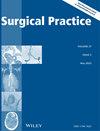Does the COVID-19 pandemic change clinic features and treatment of intussusception in children?
Abstract
Aim
Social restrictions during the coronavirus disease 2019 (COVID-19) pandemic decreased the incidence of viral diseases. Intussusception may exhibit seasonal variation, and viral aetiology is a common cause of idiopathic cases. This retrospective study was conducted to evaluate the impact of the COVID-19 pandemic on the clinical course and treatment of intussusception in children.
Patients and Methods
Patients admitted between March 2017 and December 2021 were retrospectively evaluated for age, gender, clinical findings, symptoms, length and localisation of intussusception, and treatment. They were categorised into two groups: before the pandemic (BP) and during the pandemic (DP).
Results
A total of 55 patients were included in the study, with 54 (78%) in the BP group and 11 (22%) in the DP group. The median age of the patients was significantly younger in the DP group (P < .05). Contrast enema reduction was a common treatment choice in the BP group, whereas ultrasound-guided hydrostatic reduction was more popular in the DP group (P < .05). The median time to start oral feeding and length of hospitalisation were significantly shorter in the DP group (P < .05). While there was no difference in seasonal occurrences of intussusception, idiopathic causes were more common in the BP group (P < .05). The incidence of intussusception with a leading point as an underlying aetiology was significantly higher in the DP group (P < .05).
Conclusion
During the pandemic, the rate of idiopathic intussusception significantly decreased, with leading points accounting for half of the cases.

 求助内容:
求助内容: 应助结果提醒方式:
应助结果提醒方式:


